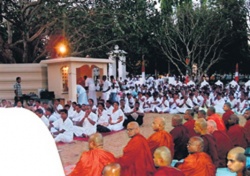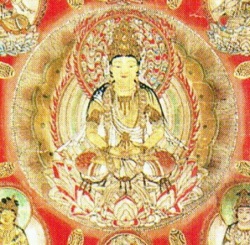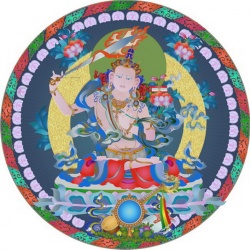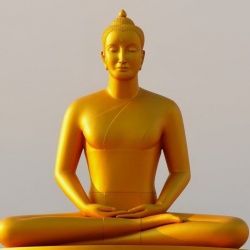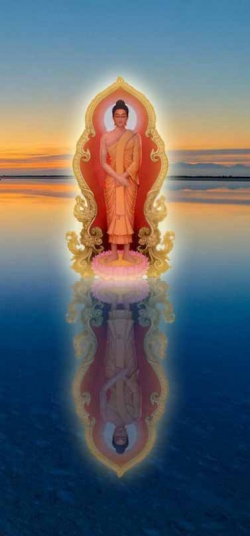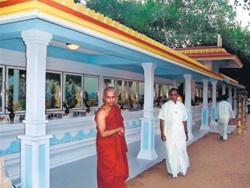Difference between revisions of "Paying homage to the 28 Buddhas - Poya feature"
(Created page with "thumb|250px| <poem> Not many temples in Sri Lanka have an `ata visi budu medura' – an image house portraying the 28 Buddhas. Where such image houses ar...") |
|||
| (5 intermediate revisions by the same user not shown) | |||
| Line 1: | Line 1: | ||
| − | [[File:Pls13.jpg|thumb|250px|]] | + | [[File:Pls13.jpg|thumb|250px|]]<nomobile>{{DisplayImages|1295|684|3566|4539|689}}</nomobile> |
| + | |||
| + | |||
| + | |||
| + | |||
| + | <poem> | ||
| + | Not many [[temples]] in [[Sri Lanka]] have an `[[ata visi budu medura]]' – an image house portraying the [[28 Buddhas]]. Where such image houses are erected, {{Wiki|devotees}} venerate them with much [[respect]] and reverence. | ||
| + | |||
| + | At Vajiraramaya in [[Anuradhapura]], a newly erected '[[ata visi budu medura]]' was opened last [[week]] in the presence of a large [[gathering]] of {{Wiki|devotees}}. | ||
| + | |||
| + | Clad in white, they sat on mats spread on the sandy ground in and around the [[Bo tree]] with the evening breeze providing a comfortable setting. [[Offerings]] of [[flowers]], [[incense]] and '[[gilampasa]]' by the {{Wiki|clergy}} and the laity marked the opening of the '[[budu medura]]'. | ||
| + | |||
| + | It was followed by a '[[bodhi]] [[puja]]'. | ||
| + | |||
| + | Based on a {{Wiki|concept}} by the young, energetic {{Wiki|patron}} [[monk]], [[Venerable]] [[Talalle Chandakitthi]] [[Thera]], the [[Dhammadeepa Foundation]] had undertaken the task of erecting the '[[budu medura]]' to honour the Most [[Venerable]] [[Madihe Pannasiha Maha Nayaka]] [[Thera]] and [[Venerable]] [[Gangodawila Soma]] Thera]] for their immense service to the [[Sasana]] and the {{Wiki|nation}}. | ||
| + | |||
| + | While housing the [[statues]] of the [[28 Buddhas]], each statue has been placed in the backdrop of the particular [[tree]] under which each of the [[Buddhas]] [[attained]] [[Enlightenment]]. | ||
| + | |||
| + | The list starts with Thanhankara [[Buddha]] who [[attained]] [[Enlightenment]] under a '[[ruk attana bodhiya]]' followed by [[Medhankara]] [[Buddha]] under the 'kaela bodhiya'. | ||
| + | |||
| + | |||
| + | |||
| + | The list continues: | ||
| + | |||
<poem> | <poem> | ||
| − | + | [[Saranankara Buddha]] ('pulila'), | |
| + | [[Deepankara Buddha]] ('neralu'), | ||
| + | [[Kondanna Buddha]] ('sal'), | ||
| + | [[Mangala Buddha]] ('na'), | ||
| + | [[Sumana Buddha]] ('na'), | ||
| + | [[Revata Buddha]] ('na'), | ||
| + | [[Sobhita Buddha]] ('na'), | ||
| + | [[Anomadassi Buddha]] ('kumbuk'), | ||
| + | [[Paduma Buddha]] ('murutha'), | ||
| + | [[Narada Buddha]] ('murutha'), | ||
| + | [[Padumuttara Buddha]] ('kiripalu'), | ||
| + | [[Sumedha Buddha]] ('bak mee'), | ||
| + | [[Sujatha Buddha]] ('una'), | ||
| + | [[Piyadassi Buddha]] ('kumbuk'), | ||
| + | [[Atthadassi Buddha]] ('sapu'), | ||
| + | [[Dhammadassi Buddha]] ('rankaraw'), | ||
| + | [[Siddhatta Buddha]] ('knihiri'), | ||
| + | [[Tissa Buddha]] ('kohomba'), | ||
| + | [[Phussa Buddha]] ('nelli'), | ||
| + | [[Vipassi Buddha]] ('palol'), | ||
| + | [[Sikhi Buddha]] ('etamba'), | ||
| + | [[Vessabhu Buddha]] ('sal'), | ||
| + | [[Kakusanda Buddha]] ('[[maara]]'), | ||
| + | [[Konagama Buddha]] ('dimbul'), | ||
| + | [[Kassapa Buddha]] ('nuga') and | ||
| + | [[Gautama Buddha]] ('asathu'). | ||
| + | </poem> | ||
| + | |||
| + | Explaining the significance of the [[28 Buddhas]], [[Chandakitthi]] [[Thera]] says they have been identified as the ones from whom [[Gautama]] the [[Buddha]] as a [[Bodhisatva]] obtained '[[niyatha vivarana]]' (asseveration) over many centuries. | ||
| + | |||
| + | The details have been recorded in [[Buddha Vansaya]], a [[Tripitaka]] volume. | ||
| + | |||
| + | |||
| + | The [[Bodhisatva]] obtains '[[niyatha vivarana]]' in [[three ways]] - by | ||
| − | + | <poem> | |
| + | [[seeing]] a [[Buddha]], | ||
| + | by meeting a [[Buddha]] and | ||
| + | by getting a [[Buddha]] to pronounce that he would definitely become a [[Buddha]]. | ||
| + | </poem> | ||
| + | </poem> | ||
| − | + | <poem> | |
| + | The [[Buddhas]] fall into three categories - | ||
| − | + | <poem> | |
| + | '[[saddhadhika]] ' - those whose forte is piety and [[devotion]], | ||
| + | '[[pragnadhika]]' - [[wisdom being]] their highlight and | ||
| + | '[[veerayadhika]]' - those with [[courage]] and [[bravery]]. | ||
[[File:Pls16.jpg|thumb|250px|]] | [[File:Pls16.jpg|thumb|250px|]] | ||
| − | India has always been the country where those who aspired to be Buddhas were born. The environment has been most conducive for them to make their appearance. Five conditions - referred to as 'pas maha belum' - had to be fulfilled before a Bodhisatva reached the final stage of reaching Buddhahood. Chandakitthi Thera explains the significance of each of them. Time ('kaalaya') should be when people are looking for the truth; Country ('deepaya') which has always been Jambudvipa - where both the rich and poor exist thus making the people realise that there is a mix of the two; Region ('deshaya') which has been the Magadha region where Pali was the spoken language; Caste ('kulaya') generally of royalty which is highly recognised and accepted; Mother ('maatha') should be a pious and virtuous lady. | + | </poem> |
| + | |||
| + | [[India]] has always been the country where those who aspired to be [[Buddhas]] were born. | ||
| + | |||
| + | The {{Wiki|environment}} has been most conducive for them to make their [[appearance]]. Five [[conditions]] - referred to as '[[pas maha belum]]' - had to be fulfilled before a [[Bodhisatva]] reached the final stage of reaching [[Buddhahood]]. | ||
| + | |||
| + | Chandakitthi [[Thera]] explains the significance of each of them. | ||
| + | |||
| + | [[Time]] ('[[kaalaya]]') should be when [[people]] are looking for the [[truth]]; | ||
| + | |||
| + | Country ('[[deepaya]]') which has always been [[Jambudvipa]] - where both the rich and poor [[exist]] thus making the [[people]] realise that there is a mix of the two; | ||
| + | |||
| + | Region ('[[deshaya]]') which has been the [[Magadha]] region where [[Pali]] was the spoken [[language]]; | ||
| + | |||
| + | [[Caste]] ('[[kulaya]]') generally of royalty which is highly recognised and accepted; Mother ('[[maatha]]') should be a pious and [[virtuous]] lady. | ||
| + | |||
| + | |||
| + | The [[sight]] of the [[28 Buddhas]] in the well lit '[[budu medura]]' at the [[Vajiraramaya]] is so [[serene]] and [[peaceful]]. Hereafter every [[Sunday]] morning, the '[[daham pasal]]' students will assemble in front of the [[statues]], offer [[flowers]] and [[chant]] the [[stanzas]] before starting to learn the [[dhamma]]. | ||
| + | |||
| + | [[Poya]] days will find {{Wiki|devotees}} making [[offerings]] and paying their respects. | ||
| − | + | by [[D.C. Ranatunga]] | |
| − | |||
</poem> | </poem> | ||
{{R}} | {{R}} | ||
Latest revision as of 04:27, 10 January 2016
Not many temples in Sri Lanka have an `ata visi budu medura' – an image house portraying the 28 Buddhas. Where such image houses are erected, devotees venerate them with much respect and reverence.
At Vajiraramaya in Anuradhapura, a newly erected 'ata visi budu medura' was opened last week in the presence of a large gathering of devotees.
Clad in white, they sat on mats spread on the sandy ground in and around the Bo tree with the evening breeze providing a comfortable setting. Offerings of flowers, incense and 'gilampasa' by the clergy and the laity marked the opening of the 'budu medura'.
It was followed by a 'bodhi puja'.
Based on a concept by the young, energetic patron monk, Venerable Talalle Chandakitthi Thera, the Dhammadeepa Foundation had undertaken the task of erecting the 'budu medura' to honour the Most Venerable Madihe Pannasiha Maha Nayaka Thera and Venerable Gangodawila Soma Thera]] for their immense service to the Sasana and the nation.
While housing the statues of the 28 Buddhas, each statue has been placed in the backdrop of the particular tree under which each of the Buddhas attained Enlightenment.
The list starts with Thanhankara Buddha who attained Enlightenment under a 'ruk attana bodhiya' followed by Medhankara Buddha under the 'kaela bodhiya'.
The list continues:
<poem>
Saranankara Buddha ('pulila'),
Deepankara Buddha ('neralu'),
Kondanna Buddha ('sal'),
Mangala Buddha ('na'),
Sumana Buddha ('na'),
Revata Buddha ('na'),
Sobhita Buddha ('na'),
Anomadassi Buddha ('kumbuk'),
Paduma Buddha ('murutha'),
Narada Buddha ('murutha'),
Padumuttara Buddha ('kiripalu'),
Sumedha Buddha ('bak mee'),
Sujatha Buddha ('una'),
Piyadassi Buddha ('kumbuk'),
Atthadassi Buddha ('sapu'),
Dhammadassi Buddha ('rankaraw'),
Siddhatta Buddha ('knihiri'),
Tissa Buddha ('kohomba'),
Phussa Buddha ('nelli'),
Vipassi Buddha ('palol'),
Sikhi Buddha ('etamba'),
Vessabhu Buddha ('sal'),
Kakusanda Buddha ('maara'),
Konagama Buddha ('dimbul'),
Kassapa Buddha ('nuga') and
Gautama Buddha ('asathu').
Explaining the significance of the 28 Buddhas, Chandakitthi Thera says they have been identified as the ones from whom Gautama the Buddha as a Bodhisatva obtained 'niyatha vivarana' (asseveration) over many centuries.
The details have been recorded in Buddha Vansaya, a Tripitaka volume.
The Bodhisatva obtains 'niyatha vivarana' in three ways - by
seeing a Buddha,
by meeting a Buddha and
by getting a Buddha to pronounce that he would definitely become a Buddha.
</poem>
The Buddhas fall into three categories -
<poem>
'saddhadhika ' - those whose forte is piety and devotion,
'pragnadhika' - wisdom being their highlight and
'veerayadhika' - those with courage and bravery.
India has always been the country where those who aspired to be Buddhas were born.
The environment has been most conducive for them to make their appearance. Five conditions - referred to as 'pas maha belum' - had to be fulfilled before a Bodhisatva reached the final stage of reaching Buddhahood.
Chandakitthi Thera explains the significance of each of them.
Time ('kaalaya') should be when people are looking for the truth;
Country ('deepaya') which has always been Jambudvipa - where both the rich and poor exist thus making the people realise that there is a mix of the two;
Region ('deshaya') which has been the Magadha region where Pali was the spoken language;
Caste ('kulaya') generally of royalty which is highly recognised and accepted; Mother ('maatha') should be a pious and virtuous lady.
The sight of the 28 Buddhas in the well lit 'budu medura' at the Vajiraramaya is so serene and peaceful. Hereafter every Sunday morning, the 'daham pasal' students will assemble in front of the statues, offer flowers and chant the stanzas before starting to learn the dhamma.
Poya days will find devotees making offerings and paying their respects.
</poem>
